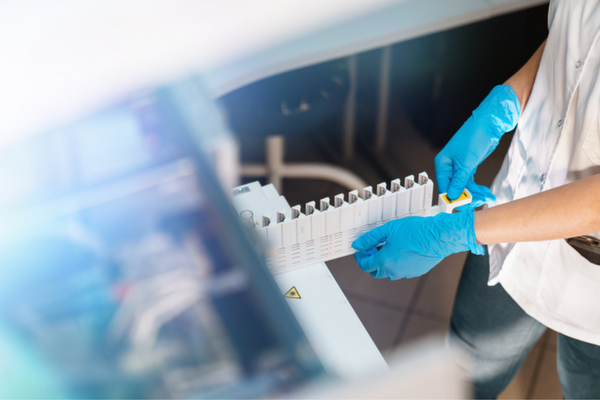
Key Takeaways:
- Karin Briner shares thoughts on how the pandemic has changed the way research is conducted at Novartis
- How Briner plans on sustaining the new level of engagement brought on by the circumstances of the pandemic
- Briner shares an anecdote that gives us an inside understanding of challenges in the pharma industry
How will the way research is done by your team at Novartis change, as a result of what you have observed during the pandemic?
The pandemic, with the sudden shift to distributed work, has created a rare situation for us to re-think how we do our work. We have learned a lot together and will build on it going forward.
Especially, the digital transformation of our work has been accelerated during this last year. There has been broad adoption of machine learning and automation to enhance decision making, research processes and operational efficiency, and this will continue.
We have also quickly gotten used to virtual tools for communication and engaging everyone. The opportunity for inclusion of scientists with important expertise independent of location and the additional flexibility of remote working is highly appreciated. There is strong agreement that we want to keep this flexibility going forward, which also helps our cross-site and external collaborations and has brought us all closer together globally.
At the same time, the presence in and the proximity to the laboratories will continue to be essential for our work, as well as face-to-face interactions to build collaborations and relationships, and we don’t want to underestimate the power of chance interactions for generating new ideas.
In an online panel discussion from May 1, 2020, you said a positive aspect of the lockdown was the ‘democratization of research and ideas.’ This was sparked by noting that team members who rarely, if ever, spoke up during face-to-face meetings, readily participated as part of a Zoom box. How do you plan to maintain this expanded engagement when the world returns to ‘normal’?
In the new ‘normal’, we will keep these diverse channels of communication as part of our interactions. Giving people a chance to speak up in what is the most comfortable way for them is so essential for capturing the insights from all our amazingly talented co-workers. We have the technology to do it, and through it, can enhance the overall experience and the dynamics in the meetings.
On a similar note, would you expect the way pharma companies collaborate to change as a result of the shared successes of 2020? If so, how?
Certainly, this last year has emphasized and made broadly visible the power of collaborations between pharmaceutical companies and the broader biopharmaceutical and research community. It is inspiring how much can be accomplished in compressed time when everyone works together towards the same goal, with urgency.
Our industry is driven by people who are passionate about having an impact on people’s lives and there is a tradition of collaboration to reach patients faster or more effectively. At Novartis, such collaborations are an important aspect of our work.
The collaboration models have evolved over the years. There are varying focuses, ranging from drug discovery and development to clinical trials, where companies share their expertise to develop therapeutics for a broad range of diseases, or where companies bring together knowledge and data to establish or advance new technologies.
The urgency that has come with the pandemic has inspired many new collaborations and got them off the ground with great speed. The spirit of collaboration continues, as there is strong support across the globe to boost vaccine production and distribution. For example, as announced in the news, Novartis plans to provide manufacturing capacity for the Pfizer/BioNTech vaccine to support the vaccine production.
And, indeed, I believe the shared success stories will stimulate the start of other collaborations and build on the joint learning.
For those of us who work outside of the pharma industry, can you give us an analogy that will help us better understand the challenges associated with developing and distributing a successful vaccine in less than one year?
It is an accomplishment that had been considered a moonshot goal a year ago, reaching the previously unthinkable; it will now change expectations for vaccine development forever.
Vaccine development has been described as a long, complex process, often lasting a decade or more, involving a combination of public and private institutions. Many candidate vaccines never progress beyond the pre-clinical stage because they fail to produce the desired immune response.
The ones that succeed progress to clinical studies where the safety and efficacy in humans is evaluated in great detail, moving forward stepwise through three phases of clinical studies, from small patient groups to larger groups, if successful. An important component are also the data reviews by the regulatory authorities, who will also inspect the factory where the vaccine will be produced and who will continue to monitor the production of the vaccine.
It has taken remarkable foresight, scientific preparedness, many people and institutions coming together, and a bit of luck of the brave to achieve what has been unprecedented in so many ways.
The scientific preparedness comes on one hand from the scientific work done and the knowledge acquired over the years on coronaviruses, and on the other hand, from the expertise built only during the last ten years, with a novel technology utilizing mRNA to generate proteins in the body.
The creation of the currently authorized COVID-19 vaccines for emergency use relied on these major scientific advancements. Had this virus come ten years earlier, the science would not have been ready. It is a remarkable testimony to how investment in basic research is for the benefit of everyone.
In general, once vaccines are approved and production sites inspected, the production is ramping up and distribution systems are tapped into to reach the necessary capacity. Imagine the very different situation and pressure in this pandemic, where everyone expected the product before production started.
In summary, we are witnessing an amazing achievement of what had to be accomplished to get to this point: creating what has not yet existed, stepwise evaluation for efficacy and safety, producing the vaccines in large quantities with consistently reproducible quality, and distributing the product broadly and reliably.
What have you learned about yourself since the start of the pandemic?
I surprised myself how quickly I adjusted to a new ‘normal’. The ability to see an opportunity in every challenge helped me not to want to “wait out” the unusual times but shape the new ‘normal’ and continue to learn and grow, while the situation would continue to change.
With respect to my team, it meant applying the same curiosity and creativity that serves science well, to explore how to best support them. I have learned a lot by listening.
While I have always enjoyed quiet time alone as a very creative space to shape ideas and work intensely, I think I have only realized through this experience how important humor and sharing laughter is to me.
What are some personality traits that have been most instrumental in your career success?
I would say creativity, courage, resilience, and compassion have been instrumental.
Importantly, any strength in exaggeration can become a weakness in certain situations, therefore, I would add the ability to put up a mirror, i.e. being self-aware, and keeping a sense of humor.
With respect to your scientists at Novartis, what non-technical skills do you most highly value?
Our mission at Novartis to reimagine medicine and invent novel breakthrough therapeutics, bringing them with urgency to the patients, takes many talented scientists from diverse disciplines who work together through complex, unprecedented problems toward their one common goal. Therefore, the ability to deal with ambiguity and cut through complexity, turning setbacks into learning opportunities, being open to new ideas, and a collaborative, inclusive mindset, are in my opinion, important non-technical skills contributing to success.
How have your parents influenced your leadership style?
My parents have always role-modeled strong work ethics and continue to do so. They have instilled in all their children the pleasure of continuous learning and of doing a job well in all aspects. They showed us the importance of caring, to care about doing a job well, about people, family and the community. They have also taught me to put others first, have empathy, and utilize my skills to make a difference.
I have learned so much from them. My father knew everyone he worked with or worked around him, both professionally and personally; there was a lot of mutual trust, respect, and appreciation. I have always been impressed how much he highlighted people’s strengths, encouraged them and related to them. On our Sunday family trips, sitting in the back of the car and listening to Dad, I got some of the most defining leadership lessons, and the desire to work hard to create a supportive, inspiring environment where people can excel at their best.
What technology trends are you following most closely, with an eye toward how they may impact the work of your scientists, and Novartis’ future growth?
These are exciting times for innovation in biomedical research, and there are many trends to keep an eye on.
Of special interest are new approaches to modulate biological targets, going beyond more traditional inhibitors and activators, such as targeted protein degradation, stabilization of protein-protein interactions, and RNA-modulating small molecules, to name a few.
Ultimately, we want to select the mode of action that is best tailored to the biological target we want to drug. The versatility of small molecules to modulate complex biological target systems is impressive, and the diverse choices for mode of action provide fertile ground to get into traditionally difficult to drug target space. Technology advances in structure-based drug discovery, such as cryo-electron microscopy, are key enablers in this area.
We are also paying attention to novel modalities, going beyond small molecules and simple biologics, considering “mixed” modalities, such as bioconjugates and radioligand therapies. In some of these areas, we are collaborating seamlessly with our colleagues in biologics to combine the best of chemistry and bioengineering to create novel compounds to address unsolved problems.
We continue to be interested in new technologies that help distribute compounds, preferentially to the site of action to obtain high efficacy with minimal side-effects. Such approaches are important in our pursuit of transformational medicines where we might work on highly interesting biological targets for efficacy, but with potentially undesired side-effects due to their central biological functions and broad distribution in the body.
Artificial intelligence is an area that has the potential to drive much transformation. Machine learning, which is an area of artificial intelligence, is not new and we have already seen good impact in drug discovery through virtual screening techniques and predictive tools for compound prioritization. Our ability to produce large datasets through high throughput experiments and the increased computational power, together with sophisticated algorithms, allow to build more complex and meaningful models. The use of such models will continue to advance many aspects of drug discovery.
What’s the one piece of advice you wish you had received when you began your current role with Novartis?
Probably that the importance of direct and frequent communication with all people in the department cannot be overemphasized. This is especially important when entering a large company mid-career, where one has not had a chance to get to know people, and them to get to know you, when working next to each other in the lab and on project teams.
Overall, I have been fortunate to have wonderful mentors all along whose advice has helped me a lot at different stages of my career. I’d like to take this opportunity to thank them for their generosity.
You have spoken highly of Leonardo da Vinci as a scientist and an artist. Is there a connection between his skills, and what you try to achieve in your role at Novartis?
Indeed, I have always been fascinated by Leonardo da Vinci, as he has expressed his creativity both as scientist and artist, highlighting some commonality. His ability to imagine beyond what has been done and introduce new perspectives, is inspiring.
As we are pursuing breakthrough medicines at Novartis and are developing new approaches to target harder and more complex biological systems, it is important to build on a strong scientific foundation and use this same foundation not to be limited by dogma but to dare to ask ‘why’ and ‘what if’. It means we will constantly push the boundaries of drug discovery to continue to extend and improve the lives of patients worldwide.
What’s the one thing you left behind in Switzerland that you would most enjoy readily accessing from your current home in the Cambridge, MA area?
I very much love the environment in Cambridge and living in the US. What I miss most is my broader family in Switzerland, and not being able to pop around for a quick visit and catch up over coffee. Beyond that I miss the easy accessibility of the beautiful and diverse countryside, hopping on the train and going for a hike.

Karin leads Global Discovery Chemistry at Novartis and has responsibility for discovery chemistry research globally across all disease areas. She focuses with her team on delivering a continuous stream of first-in-class and differentiated molecules to the clinic.
Throughout her career, Karin has stayed close to the scientific experiment, contributing as inventor and maintaining her own chemistry laboratory still when she had responsibilities as Executive Director.
She serves as member of several advisory boards to support initiatives in the public and scientific community and has regularly served as a symposium organizer and session chair for chemistry and medicinal chemistry conferences. She also participated in starting the Innovative Medicines Initiative as a member of efpia’s Research Directors Group in 2007-2010.
Before joining Novartis in 2011, Karin was at Eli Lilly and Company, where she was Vice President of Translational Sciences and Technologies with responsibilities for biomarker discovery research, structural biology, and in vitro screening. Karin had started her industry career at Eli Lilly in Indianapolis as Senior Organic Chemist in Infectious Diseases. She led projects in Neuroscience and Endocrine Research, was Executive Director of Lead Optimization Chemistry, then Managing Director of the Lilly Research Centre in the UK and a member of the board of Eli Lilly and Co., Ltd. before returning to Indianapolis to lead Translational Sciences and Technologies.
Karin obtained her BSc in chemistry and biochemistry and her PhD in organic chemistry from the University of Zurich, working with Professor Vasella. She did NSF and NIH postdoctoral studies with Professor Bill Roush at Indiana University.
This article has been edited for length and clarity. The opinions expressed in this article are the author's own and do not necessarily reflect the view of their employer or the American Chemical Society.
Copyright 2022 American Chemical Society (All Rights Reserved)











